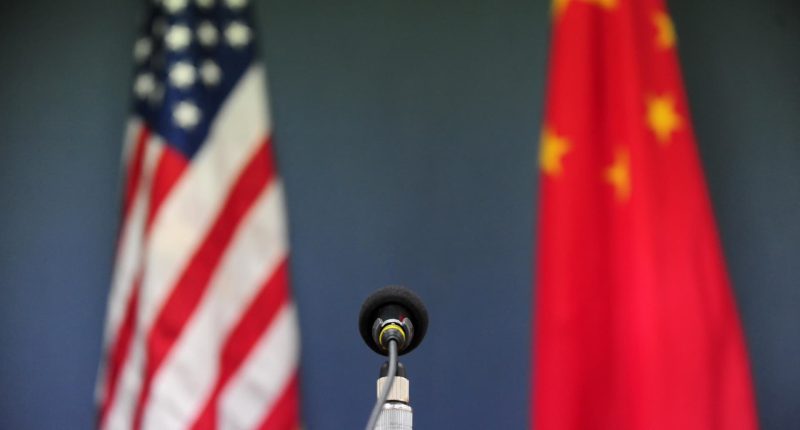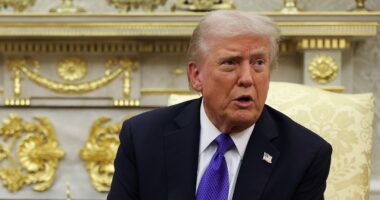Share this @internewscast.com
The U.S. and China flags stand behind a microphone at the U.S. Embassy in Beijing on April 9, 2009.
Frederic J. Brown | AFP | Getty Images
This report is from this week’s CNBC’s The China Connection newsletter, which brings you insights and analysis on what’s driving the world’s second-largest economy. Each week, we’ll explore the biggest business stories in China, give a lowdown on market moves and help you set up for the week ahead. Like what you see? You can subscribe here.
The big story
The world got a taste of an effective U.S.-China trade embargo, and after a breakthrough on Monday with lowered tariffs, there’s no going back. China now has the “mutual respect” it has long craved from the U.S.
U.S. Treasury Secretary Scott Bessent told CNBC’s Joe Kernen that “there is a sense of mutual respect” during the talks, a point that U.S. Trade Representative Jamieson Greer also emphasized in his remarks to the press on Monday.
U.S. Secretary of the Treasury Scott Bessent and U.S. Trade Representative Jamieson Greer address the media after trade talks with China in Geneva, Switzerland, May 11, 2025.
Martial Trezzini | Via Reuters
That’s in stark contrast to how the first high-level bilateral meeting under the Biden administration kicked off with an exchange of insults in Alaska, followed by a “balloon incident” that delayed then-U.S. Secretary of State Antony Blinken’s first visit to China for months.
What’s also rare is that on Monday, the U.S. and China released a joint statement — something both sides haven’t done since November 2023 with the “Sunnylands” statement on climate cooperation.
Looking ahead, it will be critical to see whether joint statements will be issued after major meetings, or revert to separate readouts, a senior advisor to world governments and business leaders, who has regular dialogue with top officials from both countries, told CNBC. The source requested anonymity due to the sensitive nature of the conversations.
The source expects volatility is likely around tariffs — an important point of flexibility for Trump as a tool for managing relations with major powers. The source added that a possible resolution could involve large Chinese purchases from the U.S., investments in the U.S. that create jobs, while Beijing gets concessions core to its interests.
New business landscape
While the elevated tariffs didn’t last long, the trauma is real. Businesses now know they need to mitigate tariff uncertainty.
“The post-WWII trade framework that once underpinned stable expectations is gone; even further tariff rollbacks won’t restore it,” Jianwei Xu, senior economist at Natixis, said in a LinkedIn post Monday.
Xu added that large businesses will continue supply chain diversification, but small businesses may stop production — as overall confidence fades in the U.S. dollar as the world’s ultimate reserve currency.
In a better-than-expected outcome, the U.S. and China agreed Monday to cut back on most new tariffs on each other’s goods for 90 days while the two sides negotiate economic and trade policy.
China Shipping containers are seen at the port of Oakland, as trade tensions continued over U.S. tariffs with China, in Oakland, California, U.S., May 12, 2025.
Carlos Barria | Reuters
That’s after China, the second-largest supplier of U.S. goods last year, was the only country across the 180 nations and territories hit by “reciprocal” U.S. tariffs to retaliate.
Hong Kong’s Hang Seng Index has recovered to levels seen just before the early April escalation in trade tensions, while the S&P 500 clawed back into positive territory for the year.
“It might be just the beginning of the inevitable collision of the two largest economies,” Ting Lu, chief China economist at Nomura, said in a note Monday, adding that “the U.S. is still on the offensive, but China might learn much better on how to dig itself in for the future attack.”
China forges ahead on self-sufficiency
Within half an hour of releasing the Chinese-language version of the joint U.S. trade agreement on Monday, China’s Commerce Ministry announced that several ministries and provinces held a meeting that day for strengthening export controls on critical minerals, another area in which China dominates the supply chain.
The State Council, China’s top executive body, on Monday also published a whitepaper on national security that began by citing the Opium War, which marked the start of a traumatic period known as the “century of humiliation” in China, seared into its national consciousness. The whitepaper had similar narratives, calling for self-reliance and playing up the country’s role as a stabilizing force amid global uncertainty.
However, China’s growing emphasis on national security tends to come at a cost for some foreign entities, according to business associations.
“A 90-day suspension, while welcome, still creates significant uncertainty for U.S. companies’ business planning and costs, undermining their long-term global competitiveness,” the U.S.-China Business Council said in a statement Monday, urging China to “end unfair trade practices and market-entry barriers.”
But Beijing continued to make thinly veiled swipes at the U.S. on Tuesday at a conference with Latin American and Caribbean leaders on Tuesday.
Chinese President Xi Jinping said that “bullying and coercion only lead to isolation,” without naming any country in particular, to an audience that included the presidents of Colombia, Brazil and Chile.
Chinese President Xi Jinping attends a signing ceremony with Brazil’s President Luiz Inacio Lula da Silva (not pictured) at the Great Hall of the People in Beijing, China, May 13, 2025.
Tingshu Wang | Reuters
Even as China’s exports to the U.S. plunged by more than 20% in April, trade data show that China ramped up its exports to Southeast Asia, the European Union and Latin America.
“Despite the temporary tariff‑war reprieve, China continues to signal that it is looking to diversify away from U.S. agricultural goods,” Dennis Voznesenski, agricultural economist at CBA, said in a note Tuesday.
He cautioned that seasonality and weather in South America would impact China’s ability to reduce its U.S. purchases.
But he pointed to reports that China, on May 9, signed a letter of intent with exporters in Argentina to buy about $900 million in soybeans, corn and vegetable oil, while China has resumed soybean imports from five Brazilian firms.
China’s imports from Argentina grew by 6.4% last year to $7.03 billion, according to official data accessed through financial data provider Wind Information.
Tariff exemptions
Established trade routes can’t easily be unwound overnight, and Peking University professor Justin Yifu Lin told reporters last month he didn’t expect full decoupling between the U.S. and China — largely because of U.S. reliance on Chinese goods.
U.S. products headed to China also saw tariff exemptions “being pretty liberally, leniently enforced,” Jacob Cooke, co-founder and CEO of WPIC Marketing + Technologies, told CNBC on Tuesday. The company helps foreign brands — such as Vitamix and IS Clinical — sell online in China and other parts of Asia.
He said that, as was the case during the first Trump administration, most products being shipped to China ended up being exempted from tariffs, largely since the products had a large share of China-made components.
Looking ahead, he expects that tariffs are going to be cut, and that “the largest trading relationship in the world is going to continue.”
But for many companies that once solely relied on China-based suppliers, the sudden surge in U.S. tariffs last month is just the latest reason to broaden out.
“Smarter importers have realized that long-term, they are most secure when they are diversified, and hence will continue looking for alternative sources,” said Ash Monga, founder and CEO of Guangzhou-based Imex Sourcing Services, a supply chain management company. He launched a website last month called “Tariff Help” for small businesses to find ways to diversify from China-based suppliers.
— CNBC’s Bernice Ooi contributed to this report
Top TV picks on CNBC
Need to know
The U.S. and China are talking. Bessent and Chinese Finance Minister Lan Fo’an met in Washington, D.C., on the sidelines of an international meeting there late last month, the Financial Times reported, citing sources. After the two countries met in Switzerland over the weekend and reached a deal, investment banks have started revising up their China growth forecasts.
China’s property sector nears stabilization. That’s according to an S&P report Sunday that predicts primary home sales volume is set to moderate its decline to a 2% drop this year, versus a 17% plunge last year.
Nvidia still wants the Chinese market. The U.S. chipmaker plans to release a downgraded version of its most powerful H20 artificial intelligence chip for China in the next two months, after U.S. officials imposed export restrictions on the original model, Reuters reported Friday, citing sources.
In the markets

The performance of the Shanghai Composite over the past year.
Chinese and Hong Kong stocks climbed Wednesday as investors continue to assess the U.S.-China trade talks.
Mainland China’s CSI 300 was up 1.15% while Hong Kong’s Hang Seng Index — which includes major Chinese companies — rose 1.73% as of 2 p.m. local time.
The benchmark 10-year Chinese government bond yield is at 1.672%.
The offshore Chinese yuan weakened 0.22% against the greenback to 7.2114.
Coming up
May 14: Tencent to report quarterly earnings after the Chinese market close
May 15: Alibaba to report quarterly earnings after the Chinese market close
May 19: China to report April retail sales, industrial production and investment data
May 20: Chinese battery giant CATL to list in Hong Kong; China’s law to support the private sector takes effect









